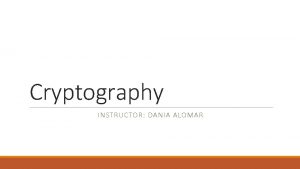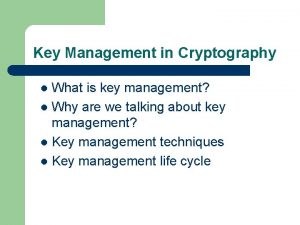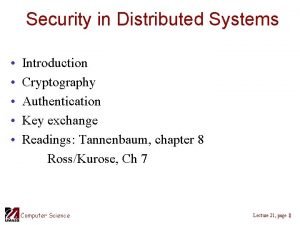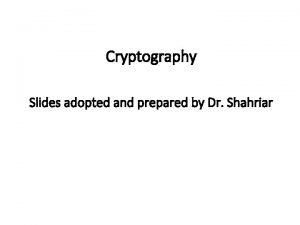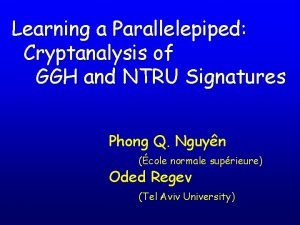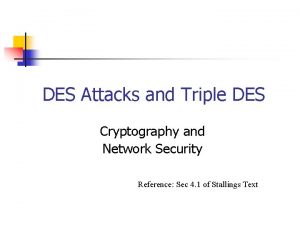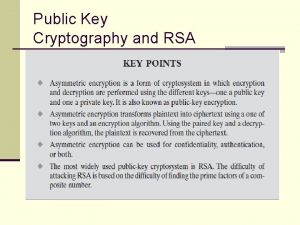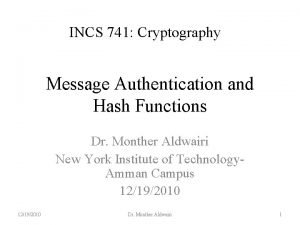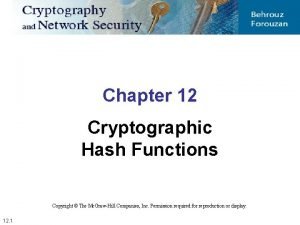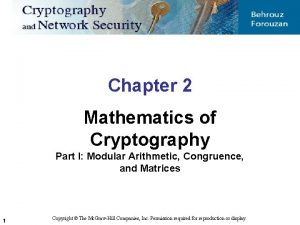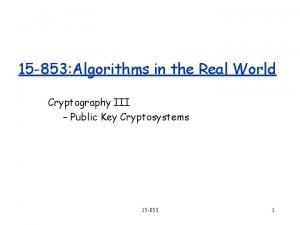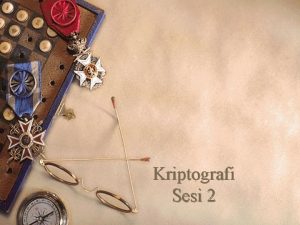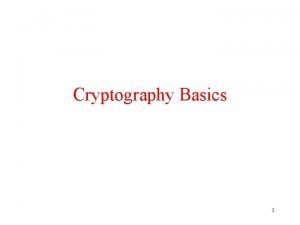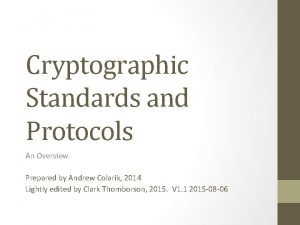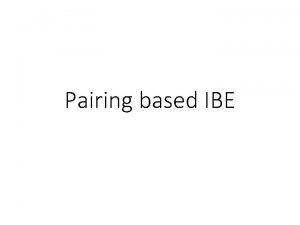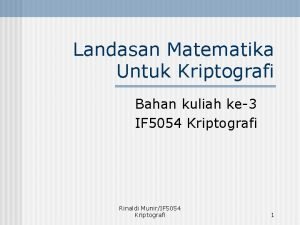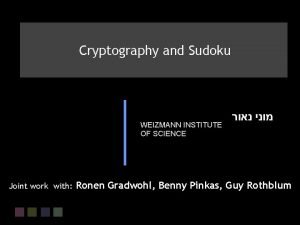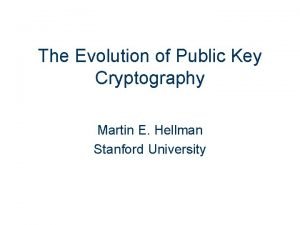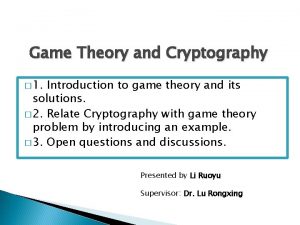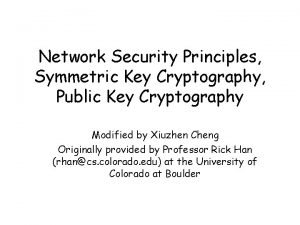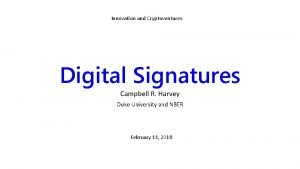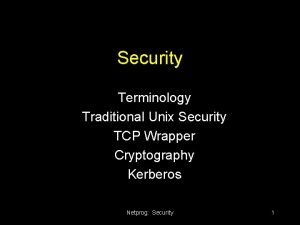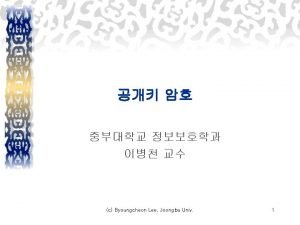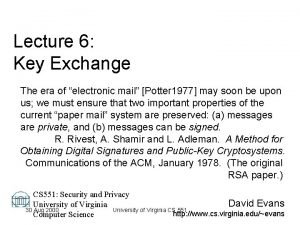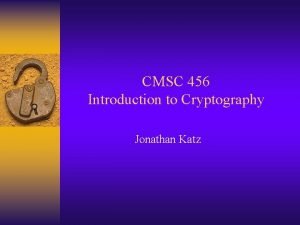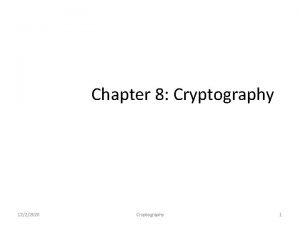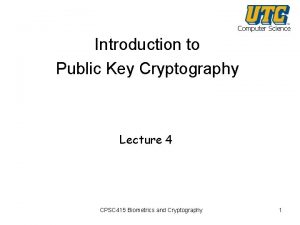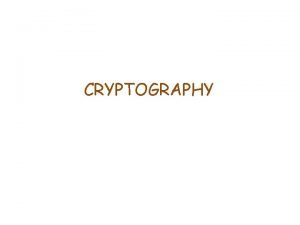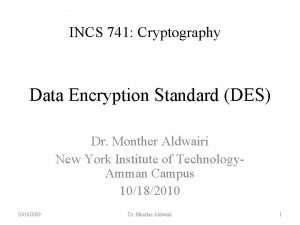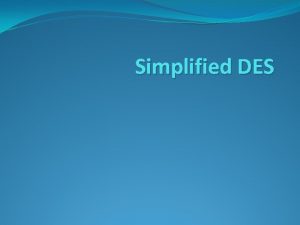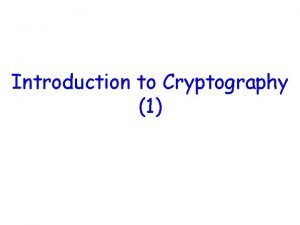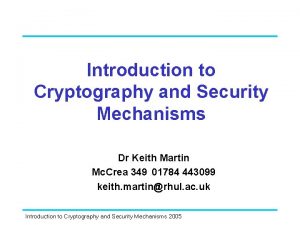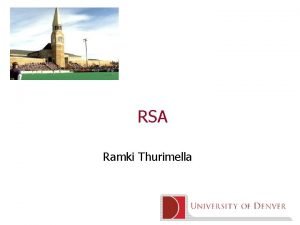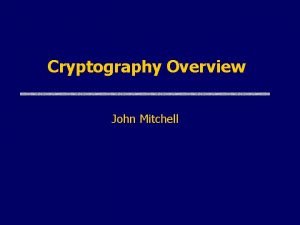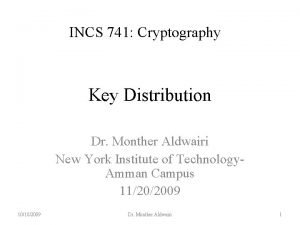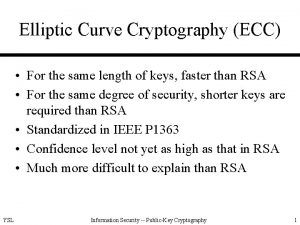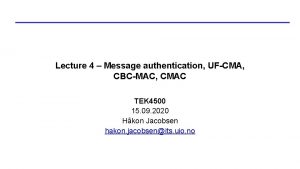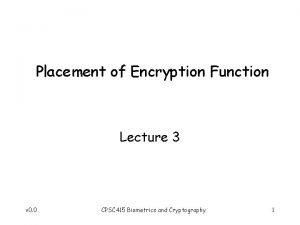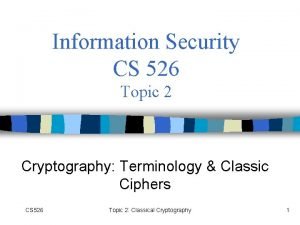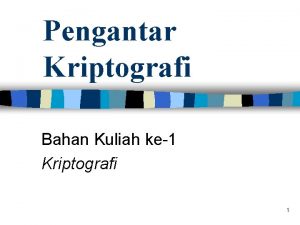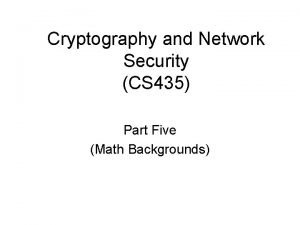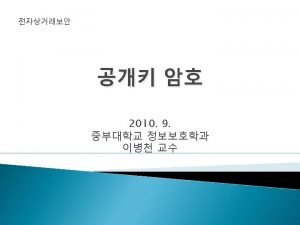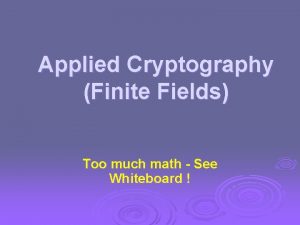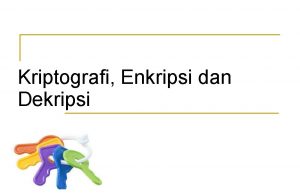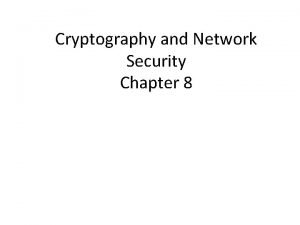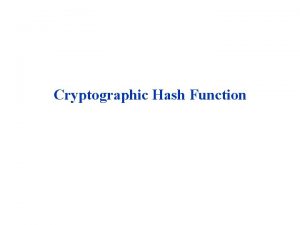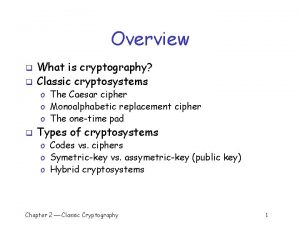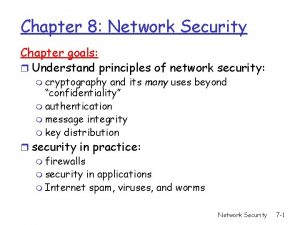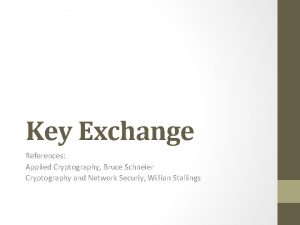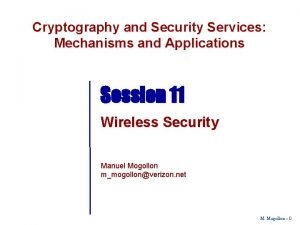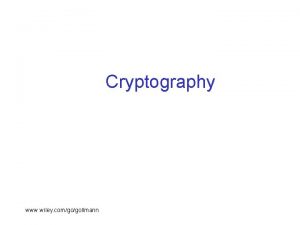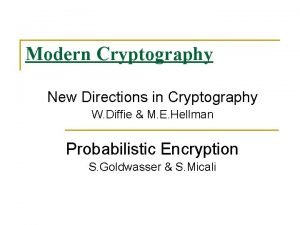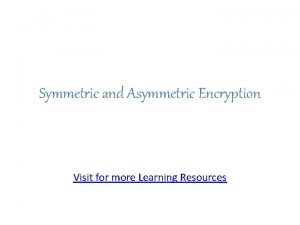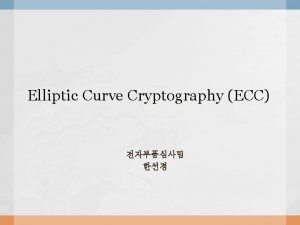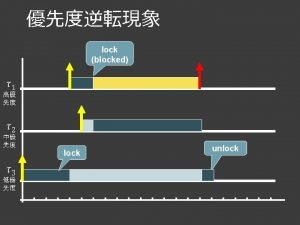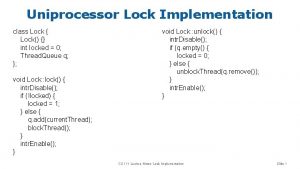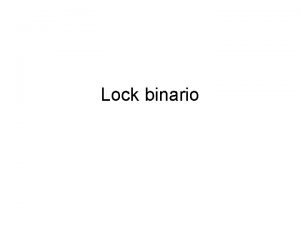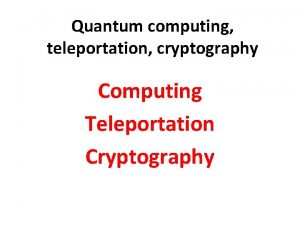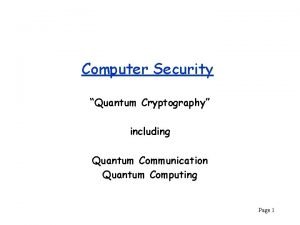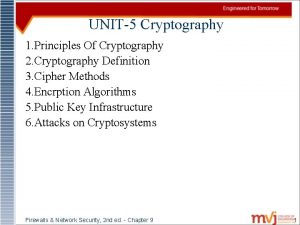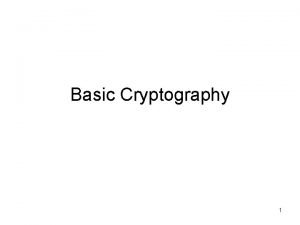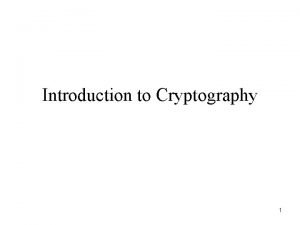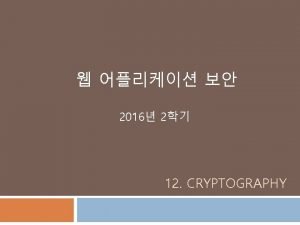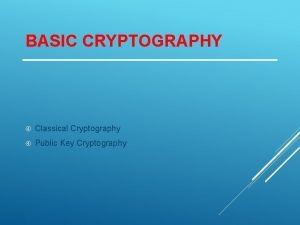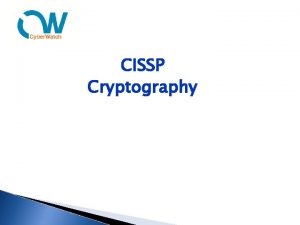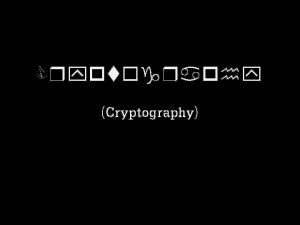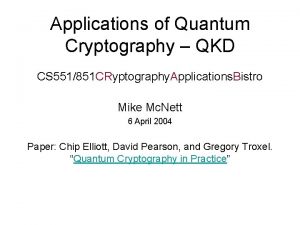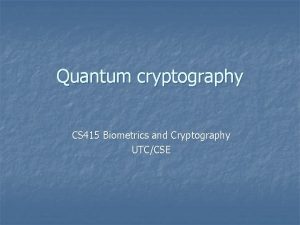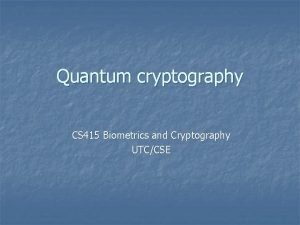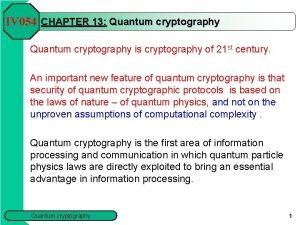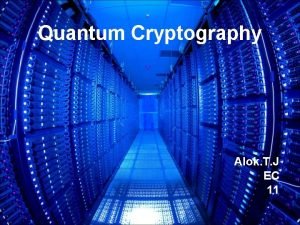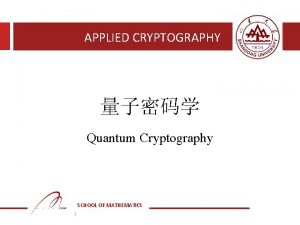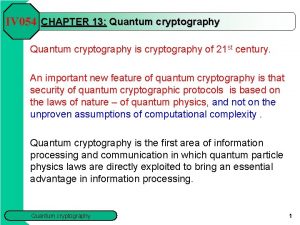Quantum Cryptography 1 e 29 LOCK 29996224275833 x







































![Result -sin(q 1 -q 2) [|00> + |11>] Coincidence + cos(q 1 -q 2) Result -sin(q 1 -q 2) [|00> + |11>] Coincidence + cos(q 1 -q 2)](https://slidetodoc.com/presentation_image/ec64489b59d45f3eb52cd35872119f2e/image-40.jpg)





![TO + OC + CT ≤ 2 P ( A & [not B] ) TO + OC + CT ≤ 2 P ( A & [not B] )](https://slidetodoc.com/presentation_image/ec64489b59d45f3eb52cd35872119f2e/image-46.jpg)



















- Slides: 65

Quantum Cryptography 1 e 29 (LOCK) = 29996224275833 x 3475385758524527 (MESSAGE/CODE) (KEY) Classical computer doing 20 GFLOPS needs 1015/20 x 109 ~ 0. 5 day to solve this Largest prime has 22, 338, 618 digits 4000 years!

Classical Computation

Inverter/NOT gate in out NOT in out 0 1 1 0

2 -input Logic Gates AND OR 0 0 0 0 1 1 1 0 0 1 1 1 1

2 -input Logic Gates NAND NOR XOR 0 0 1 1 0 0 1 1 1 0 1 1 0 SUM

NAND is universal A A A B NAND NOT AND = NOT(NAND) OR made of NAND and NOT A + B = NOT[NOT(A+B)] = NOT[NOT(A) and NOT(B)]

NAND is universal A. B A A. B B NAND A NOT A A. B = A + B NOT B

2 Bit Half-Adder A B CARRY = AND SUM = XOR A B CARRY SUM 0 0 0 1 0 1 1 1 0 2

Full-Adder A Sum S B Carry Cout Cin + B + Cin Cout = A. B + B. Cin + Cin. A S=A A B Cin S Cout 0 0 0 0 1 1 0 0 1 0 1 1 1 0 0 1 1 1

Encoder: n inputs, 2 n outputs (Identifies each A-B possibility) Enable D 0 A B D 1 A B D 3 D 2 D 1 D 0 0 0 1 0 1 0 0 1 1 1 0 0 0 D 2 D 3 D 0 = A NOR B = NOT(A) AND NOT(B) D 1 = NOT(A) AND B D 2 = A AND NOT(B) D 3 = A AND B

Decoder: 2 n inputs, n outputs Collapses possibilities Enable D 0 D 1 D 2 D 3 A B 1 0 0 0 1 0 1 0 0 1 1 1 A = D 2 + D 3 B = D 1 + D 3

2 x 1 and 4 x 1 Multiplexer (Selector) S 0 Control S A F B S=0, F=A S=1, F=B F = S. A + S. B A B C D S 1 F (S 0, S 1) = (0, 0), F=A (0, 1), F=B (1, 0), F=C (1, 1), F=D F = S 0. S 1. A + S 0. S 1. B + S 0. S 1. C + S 0. S 1. D

8 x 1 Multiplexer DEMUX S 0 S 1 S 2 D 0 D 1 D 2 D 3 D 4 D 5 D 6 D 7 S 0 S 1 S 2 F F D 0 D 1 D 2 D 3 D 4 D 5 D 6 D 7

8 x 1 DEMUX

STORAGE/MEMORY (FLIP-FLOPS) Need feedback S Q R Q S R Q Qnext 0 0 Q HOLD 1 0 1 SET 0 1 0 RESET 1 1 X NA

How do we realize these gates?

Build a “NOT” with CMOS inverters PMOS NMOS + voltage turns NMOS on, shorts to ground -voltage turns PMOS on, shorts to power supply voltage ON Gain OFF

Build a NAND with CMOS inverters NAND 0 0 1 1 1 0

Build a NOR with CMOS inverters NOR 0 0 1 0 1 0 0 1 1 0

Build an oscillator with CMOS inverters

Build memory with CMOS (DRAM, SRAM, Flash)

Energetics of Computation

Dissipation in CMOS PMOS NMOS • Leakage high with scaling IOFF • Reduce VDD Steep devices • Reduce C/ION ratio Fin. FETs F 2 D = 0. 5√L F 3 D = 0. 5√(L/Nlayers) Pdiss = IOFFVDD + a. CVDD 2 f

Dissipation in binary switching “ 0” “ 1” Barrier large enough to prevent spontaneous backflip 24

Dissipation when electron falls downhill Perr = e-q. DV/k. T < ½ q. DV > k. BTln 2 N els: (N+2)k. BTln 2 A e. VAB B 3 k. BTln 2 We’re already pretty efficient for on-chip dissipation! (Zhirnov) 25

Reversible Switching (“Moonwalking potential”) When we know where electron sits SLIDE When we don’t know where electron sits OOPS !! KNOWLEDGE CONNECTED TO DISSIPATION !

Information entropy DF = -TDS S = k. Bln. W = < k. Bln(1/p) > = -Si k. B(pilnpi)

Dissipation in CMOS DF = -TDS S = -Si k. B(pilnpi) When we know where electron sits (read and copy) Si = 0 Sf = 0 When we don’t know where electron sits Si = -k. Bln 1/2 = k. Bln 2 Sf = 0

Dissipation in AND DF = -TDS S = -Si k. B(pilnpi) 0 0 1 0 0 0 1 1 Si = -4 k. B(1/4 ln 1/4) 1 Sf = -k. B(3/4 ln 3/4 + 1/4 ln 1/4) 1 Squeezing of phase space (2 inputs, 1 output)

No Dissipation (CNOT) A A B Flip B iff A = 1 Preserve phase space Bout is XOR ! A B 0 0 0 1 1 1 0 Aout Bout SUM

CNOT is reversible ! A B Aout Bout A B

A B C CSWAP (Fredkin gate) A Flip B and C if A = 1 A B C Aout Bout 0 0 0 0 1 0 0 1 1 1 0 0 1 0 1 1 0 1 1 Cout

CCNOT (Toffoli gate) A Flip A iff B = 1 and C = 1 B B C C Set C = 1 Get A XOR B ! (Same as SUM bit) A B C Aout Bout 0 0 0 0 1 0 0 1 1 1 0 0 1 0 1 1 1 0 1 1 Cout

Quantum Computation

PRIME FACTORIZATION Use Superposition + Entanglement + reversible gates for one-shot computation • Shor’s Algorithm • Grover’s Algorithm • Kane’s Nuclear spin QC

What is Entanglement ?

EPR Paradox: Pion decay two entangled states in a singlet (e and e+ with opposite spins) |00> + |11> Move far away Measure bit 1 0 Bit 2 must collapse to 0 instantly !! (Nonlocality since light needs finite time)

Is entanglement real? Could uncertainty accommodate a hidden variable? Is uncertainty just in knowledge or fundamental ? ?

Bell’s Inequality |00> + |11> Separate particles Run each through a rotation Uq 1 x Uq 2 Uq 1= 1 |0> = 0 cosq 1 -sinq 1 cosq 1 0 |1> = 1 Uq 2 = U+(p/2 -q 2)
![Result sinq 1 q 2 00 11 Coincidence cosq 1 q 2 Result -sin(q 1 -q 2) [|00> + |11>] Coincidence + cos(q 1 -q 2)](https://slidetodoc.com/presentation_image/ec64489b59d45f3eb52cd35872119f2e/image-40.jpg)
Result -sin(q 1 -q 2) [|00> + |11>] Coincidence + cos(q 1 -q 2) [ |10> - |01>] Non-coinc P(AC = 1) = sin 2(q 1 -q 2) P(AC = -1) = cos 2(q 1 -q 2) P(AC = -1) – P(AC = 1) = P(01) + P(10) – P(00) – P(11) = correlation = cos[2(q 1 -q 2)]

Result (Alain Aspect etc)

Bell

Proof: Bell’s inequality Own vs Rent: O and O Car vs No Car: C and C TV vs No TV: T and T OCT + OCT + OCT = 1 If only two questions on a survey – coalesce info thus T T O O ? ? O C C ? ? C Jay Sulzberger T T ? ?

Proof: Bell’s inequality T T O O ? ? O C C ? ? C T T ? ? Test for accuracy: TO + OC + CT ≤ 2 Proof: LHS: OCT + OCT + OCT = 1 TOC + OCT + CTO + CTO = 2 [ 1 – OCT] ≤ 2

Bell
![TO OC CT 2 P A not B TO + OC + CT ≤ 2 P ( A & [not B] )](https://slidetodoc.com/presentation_image/ec64489b59d45f3eb52cd35872119f2e/image-46.jpg)
TO + OC + CT ≤ 2 P ( A & [not B] ) + P ( B & [not C] ) http: //arxiv. org/pdf/0704. 2529 v 2. pdf ≥ P(A

Entanglement is real Electrons are in superposition A classical measurement decouples them by entangling with an apparatus. Decoherence kills phase information

Entanglement is real How can we use this for QC ?

Prime Factorization

Useful for Quantum Cryptography 1 e 29 (LOCK) = 29996224275833 x 3475385758524527 (MESSAGE/CODE) (KEY) Classical computer doing 20 GFLOPS needs 1015/20 x 109 ~ 0. 5 day to solve this Largest prime has 22, 338, 618 digits 4000 years! Create superposition of all states related to key as input Entangle with gateable output Measure output input collapses (don’t peek yet !) Use gates to do Fourier Transform on input further collapses Now Read input From input + output reads, we can get factor !!!

SHOR’S ALGORITHM Given a number N, choose coprime a Algo (from number theory) F(x) = axmod(N) is periodic 1. Find period r of F(x) [QFT] (it’s even) 2. Candidate Factors are p, q = gcd(ar/2 ± 1, N)

Why? Solve for x 2 = 1 mod(N) ie, (x+1)(x-1) = 0 mod(N) = N So factors of N are (x+1) or (x-1) So, gcd(x+1, N) or gcd(x-1, N)

Example: N = 15, a = 7 1. Find period r of function F(x) = 7 xmod(15) F(0) = 1 F(1) = 7 F(2) = 4 F(3) = 13 F(4) = 1. . Period r = 4

2. Factors are p = gcd(74/2 + 1, 15) = gcd(50, 15) = 5 q = gcd(74/2 - 1, 15) = gcd(48, 15) = 3 At least one of them guaranteed to work

N = 143 a = 53 r=4 Gcd(ar/2+1, N) = 1 Gcd(ar/2 -1, N) = 13 143 = 13 x 11

IMPLEMENTATION (N=15, a=7) 1. Choose input and output registers Choose q such that N 2 < q=2 l < 2 N 2 [e. g. q = 256 Input register: 8 qubits, 0 …. 255] Output needs enough to capture N=15 [4 qubits]

To find periodicity r of F(x) = axmod. N Superposition, Entangle input-output |0000, 0000> + |00000001, 0000> + |00000010, 0000> + |00000011, 0000> + ……. + |1111, 0000> Operate with 7 xmod(15) 255 answers and place in output register

To find periodicity of armod. N Entangle input-output |0000, 0001> + |00000001, 0111> + |00000010, 1000> + |00000011, 1101> + repeating output [1, 4, 7, 13 in binary] Now measure output Collapse input into a subset [0, 4, 8, 12, 16, . . , 252] Period r = 4. How to read r in 1 shot?

Measure period with Q Fourier Transform (Hadamard + Phase shifters) [0, 4, 8, 12, 16, . . , 252] But with different probabilities, peaking around 252/r = 64. So highest probability are 0, 64, 128, 192. Let it collapse again Say we read p=64 Then from p=64 and q=256, we can get r=4 (continuous fraction expansion of q/p)

Finally, gcd(7 r/2 ± 1) Q superposition + QFT to speed-up


Opportunity: Quantum Cryptography Quantum Teleportation Solve many body problems

Di. Vincenzo’s 5 criteria • Scalable physical system with well Characterized qubits • Initialize • Universal set of Q-Gates H = - B. S 1 – JS 1. S 2 • Maintain Quantum Coherence • Efficient Read out

Challenge: Quantum Coherence (Kane)

Cooling Affordable ? Cloud and Io. T are important
 Quantum physics vs mechanics
Quantum physics vs mechanics Quantum physics vs quantum mechanics
Quantum physics vs quantum mechanics Introduction to cryptography and network security
Introduction to cryptography and network security Cryptology cryptography cryptanalysis
Cryptology cryptography cryptanalysis What is key management in cryptography
What is key management in cryptography Cryptography in distributed system
Cryptography in distributed system Cryptography slides
Cryptography slides Lattice based cryptography
Lattice based cryptography Des attacks
Des attacks Principles of public key cryptography
Principles of public key cryptography Authentication functions in cryptography
Authentication functions in cryptography Block ciphers and the data encryption standard
Block ciphers and the data encryption standard Digital signature in cryptography and network security
Digital signature in cryptography and network security Whirlpool cryptography
Whirlpool cryptography Congruence in cryptography
Congruence in cryptography Real world cryptography
Real world cryptography Monoalphabetic cipher adalah
Monoalphabetic cipher adalah Cryptography basics
Cryptography basics Cryptography standards and protocols
Cryptography standards and protocols Pairing based cryptography
Pairing based cryptography Algebra and cryptography
Algebra and cryptography Moni naor
Moni naor Cryptography and network security 4th edition
Cryptography and network security 4th edition Wireless security in cryptography
Wireless security in cryptography Evolution of cryptography
Evolution of cryptography Cryptography board game
Cryptography board game Public key cryptography principles
Public key cryptography principles Elliptic curve cryptography
Elliptic curve cryptography Cryptography
Cryptography New directions in cryptography
New directions in cryptography Obfuscation cryptography
Obfuscation cryptography Divisibility and division algorithm in cryptography
Divisibility and division algorithm in cryptography Katz cryptography
Katz cryptography Hill cipher decryption formula
Hill cipher decryption formula Asymmetric key cryptography
Asymmetric key cryptography Cryptography
Cryptography Des cryptography
Des cryptography Number theory in network security
Number theory in network security Sdes encryption algorithm
Sdes encryption algorithm Birthday attack
Birthday attack Cryptography and network security 6th edition
Cryptography and network security 6th edition Algebraic structures in cryptography
Algebraic structures in cryptography Cryptography and network security 6th edition pdf
Cryptography and network security 6th edition pdf Cryptography
Cryptography Cryptography
Cryptography Cryptography summary
Cryptography summary Placement of encryption function in cryptography
Placement of encryption function in cryptography Cryptography
Cryptography Ufcma
Ufcma How do you decide the placement of the encryption function?
How do you decide the placement of the encryption function? Kerckhoffs’s principle
Kerckhoffs’s principle Introduction to cryptography
Introduction to cryptography Gcd(1970,1066)
Gcd(1970,1066) New directions in cryptography
New directions in cryptography Finite fields in cryptography
Finite fields in cryptography Terminologi di dalam kriptografi
Terminologi di dalam kriptografi Euler's theorem in cryptography and network security
Euler's theorem in cryptography and network security Two simple hash functions
Two simple hash functions Cryptanalysis
Cryptanalysis Cryptography goals
Cryptography goals Schneier cryptography
Schneier cryptography Cryptography security services
Cryptography security services Study cryptography
Study cryptography New directions in cryptography
New directions in cryptography Symmetric encryption advantages
Symmetric encryption advantages Motivationsbasis
Motivationsbasis



